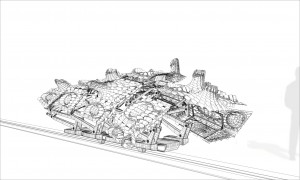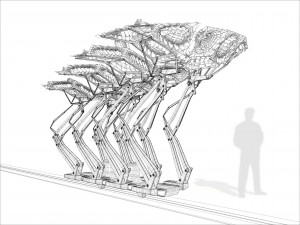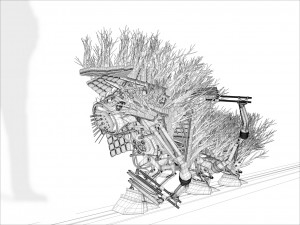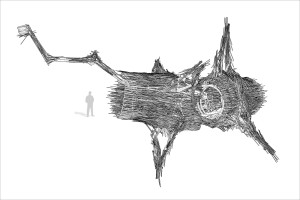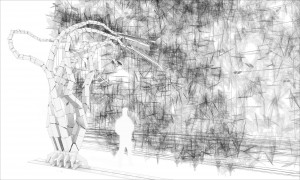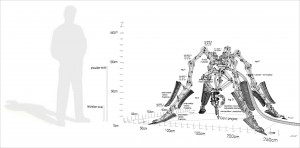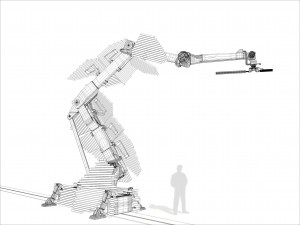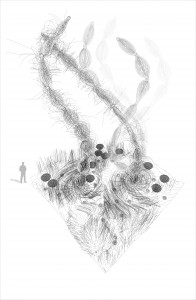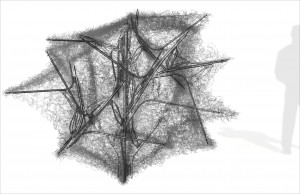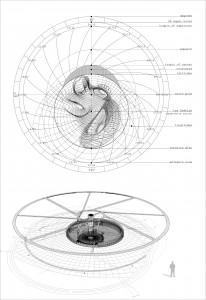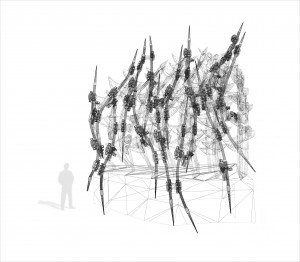Experiments by New-Territories
Text / N.T. / Francois Roche – Camille Lacadee
Machines / N.T. / Francois Roche – Stephan Henrich (including some LAB-usc/angewandte)
There are many machines, so many desirable machines that in fact pretend to do more than they are doing. In the pursuit of pataphysics – the branch of philosophy that deals with the imaginary realm – they never reveal their deep natures: whether it is their lineage or their illusionary appearance, their genuine qualities or their sham features. Simultaneously speculative, fictional and accurately and efficiently productive, these machines navigate the world of Yestertomorrowday, with happiness and innocence, walking briskly through the mountains of rubbish of the 21st century and beyond. These pataphysical machines articulate symmetrically – through weird apparatuses – different arrows of time, different layers of knowledge, but more efficiently they negotiate the endless limits of what we could consider the territory of absurdity, where illogical behaviour is protocolised with an extreme logic of emerging design and geometry, where input and output are described by mathematical rules …
Neither a satire of ‘this and other worlds’, nor a techno-pessimism or a techno-derision, these machines reside at the very limits of the dystopian or they constitute the limit between the territory of conventions, of certainties and stabilities, where it is comfortable to consider everything legitimated by an order, or an intuition of an order, and by other territories; all the other paranoid, phantasm-like imaginings reported back by travellers.
In a casual and basic sense, machines have always been used to elaborate technicism as the extension of the hand, through its replacement, its improving, its acceleration of the speed and powers of transformation, of production. However, it seems very naive to reduce the machine to this obvious objective dimension, in a purely functional and mechanical approach; limiting it exclusively to a Cartesian notion of productive power, located in the visible spectrum of appearance and fact. In parallel, machines are producing artefacts, assemblages, multiple associations and desires, and are infiltrating the very raison d’être of our own bodies and minds that are codependent on our own biotopes or habitats.1 Fundamentally, everywhere in nature, at the origin of all exchange processes, in the transaction of any substances, they are the guarantee of its vitalism.2 Machines’ coexistence with nature renders them in effect a paradigm of the body. This is true of all processes, protocols and apparatuses, where transitory and transactional substances3 constitute and affect simultaneously all the species, where machines’ identities and outputs are both object and subject.
In pursuit of this polyphonic approach, we cannot pass over the notion of ‘the bachelor machine’4 as a tentative attempt to integrate mechanical apparatuses in a narrative transaction and transmutation (in the mode of the alchemist). This is the opposite approach to a headlong critique or denouncement of capitalism that highlights the substitution of craftsmen with unskilled workers manning machines5 (the natural consequence of this now being a mechanical system without workers). Walter Benjamin described this shift as a move from the singularity of production to mass production.6 This contrasts with the nostalgic romanticism that bachelor machines evoke through our fascination with their sophisticated ‘human-made-like’ construction: their eroticism or even barbaric eroticism.7 The ‘impulsive urge’ and gut-wrenching repulsion they generate means they exist in a permanent state of schizophrenia, vacillating between the simultaneous potential of production and destruction.8 Both positive and negative processes are the product of the same industrial system; their genesis is consubstantial, and their collateral effect diametrically in opposition. They are both dependent on this schizoid potential.
Following are a few examples of those pathological strategies of narration-production.
Darwinian Star-gate
Instructions: Stand up and face the ghosts in the depths of your private garden!
Rent this vehicle to transport yourself from a seated, peaceful, sleepy archaic body posture to a standing, lucid awakened position that induces bravery in those faced with the present.
Powered by photovoltaic cells, the Darwinian Star-gate’s arms unfold on their way from a panoptical to a worrisome heterotopic space you would normally refuse to see.
The star-gate machine introduces the passage of time between two constructions of different origins and periods. As a strategy for questioning the orientation of the arrow of time, it is able to quieten the anxiety of misunderstanding provoked by the shifts between the Modern to Postmodern, Postmodern to Digital, and Digital to Robotic Computational extension, in a ‘beam me up scotty’ rhyzomatic shortcut. The travel could take an evolutionary and/or regressive trajectory. But mainly this machine is most efficiently used as a vector of discovery that reaches a point of uncertainties, of un-determinism, to escape from a zone where everything has already been flattened, classified and validated.
Its first use and development was for ‘thebroomwitch’ experiment.
Precautions for use: Using the vehicle too often might cause a sensation of time deprivation and sometimes immortality, but also ultimately a good excuse for denial of your duties in a given time. You might also lose the sense of time passing, which can significantly impair synchronising motor actions. Abuse of the device can be extremely dangerous for mental health and seriously affect the user’s temporal perception, especially in regards to the notion of a specious present. Ultimately, it can cause memory loss.
On the contrary, overexposure to the present time (staying in one time or another) might cause the user depression, cynical behaviour or other pathological distresses, which the vehicle shall not be held responsible for …
The device does not work for French architecture, which already confuses its origins.
Antipersonnel Nymphomaniac Wanderer
Instructions: Rent this machine to brave the danger and bring back to you on her back rotten species, decomposed biomass, from any ‘no-man’s land’.
The Wanderer can be transformed for collecting other materiel. All robot ‘tuning’ of terminations, articulated arms, legs and tips is authorised, under the condition that you return the machine in its initial state.
The machine collects any ingredients to be recycled in a new productive use. This grants a second life to the waste, and the trash in polluted areas such as post-military zones with unreachable infrastructure interstices.
Legends and fairytales are simultaneously transported out of the deepness of those abandoned situations, as in a ‘Stalker’ experiment to touch the unknown. Please take care of the backlash of those creatures.
Its first use and development was for the ‘itshootmedown’ experiment.
Precautions for use: The machine is originally built with a very high self-estimation sensorial device, as well as a danger-blinding component, both necessary for its brave actions and responsibilities. However, depending on the environment it is exposed to, the machine could be subject to sudden and violent changes in self-esteem.
In case of failure or small breakdown (if the danger-blind component gets hurt), the machine will exhaust itself until suicide. If you notice that the machine repeats a very high exposure to dangerous situations, put it off to avoid risks of suicidal tendencies disguised into bravery.
Introverted Eczemetal Recycler
Instructions: Transforming informal heaps into deformed ones, this machine recycles waste from metallurgic and construction sites into potential troglodyte morphologies.
This machine is still in development. It is thus available for rent under a special discount as a beta test. The provision of sufficient energy levels for the effective gathering of steel has not yet been accurately gauged, and dysfunctions may easily occur when the Recycler is in operation. We recommend for this machine only to be rented in parallel with the crane that is able to stabilise its agenda and positioning. We require feedback from customers to improve the reasons behind its design, which appear for now weak. This machine will be removed from the catalogue if there are no further reasons for it being in existence.
Precautions for use: Due to its lack of resolution, this machine is especially vulnerable.
Protect it from the feeling of identity loss by engaging with it on a private level – otherwise it might show a tendency to confuse its own being with the built environment, and develop skin camouflage diseases in order to disappear inside its own construction. An early stage of depersonalisation can be spotted by its tendency towards metallic somatisation.
Difference and Repetition/Intricate Randomiser
Instructions: Rent this device to populate a surface that will be revealed by the trajectory you convey by impulse to the machine. Its multiple arms will follow a dance of intricacy in compulsive articulated movements, giving ideal programmable empirical shape and outcomes.
This machine has to be rented with a specific number of components (only available in packages of 500 units) to be populated in any condition, any situation. The individual component is developed as a Velcro termination, self-attached by a comb-feather design, with variable positions able to assume, at your convenience, polyphonic structures; be they massive, fluid, opaque or transparent.
The machine is able to be packed in a pick-up of 3 x 2 x 1 metres (10 x 7 x 3 feet) including the tracks that are 10 metres (33 feet) long. Please refer to the installation instructions for ascertaining the dual positions of the machine/component on the ground. You will be trained in the inverse cinematic process that will enable you to draw first the structure manually, as curves in space by manipulating the machine tips, and secondly discover how the footprint of your handy movement is becoming the trajectory of the components stacking, automatically repeated and assembled by the machine (4 metres/13 feet high maximum). The intricate packing fabrication will follow the isocurves you defined in the space in a repetitive adaptation.
Precautions for use: Due to the requirement of unpredictability of its work, the machine is subject to bipolar disorder, alternating manic, hypomanic and depressive episodes of varying lengths. Although these episodes are necessary to the nature of the random intricacy process, they might in the long run cause side effects such as racing thoughts and rest (mode OFF) deprivation.
Take care of possible exhaustion of the machine, as well as of the feeling of impuissance in front of its never-ending chore.
On the contrary, if the machine shows repetitive, ordered or systematic combination processes, bring it back to the shop immediately for emergency reprogramming.
Body-Builder-Shitter
Instructions: Rent an agile hyper-proteined device, shitting liquid concrete in a vertical phallic extrusion, which is turned into coagulations that it stands on to continue the construction process in defiance of gravity.
The Shitter is only made available to rent to a minimum of 30 families, dedicated and driven by a bio-politic decision.
The device is a usable, operative machine for a self-organised micro-urbanism conditioned by a bottom-up system. The 30-plus families, called ‘the multitude’, are able to drive the entropy of their own system of construction, their own system of ‘vivre ensemble’. It is based on the potential offered by contemporary bioscience, the rereading of human corporality in terms of physiology and chemical balance to make palpable and perceptible the emotional transactions of the ‘animal body’, the headless body, the body’s chemistry, and information about individuals’ adaptation, sympathy, empathy and conflict when confronted with a particular situation and environment. The construction process developed through ‘machinism’ – indeterminate and unpredictable behaviour – with the creation of a secretive and weaving machine that can generate a vertical structure by means of extrusion and sintering (full-size 3D printing) using a hybrid raw material (a bio-plastic cement) that chemically agglomerates to physically constitute the computational trajectories. This structural calligraphy works like a machinist stereotomy composed of successive geometrics according to a strategy of permanent production of anomalies: with no standardisation, no repetition, except for the procedures and protocols at the base of this technoid slum’s emergence.
Its first use and development was for the ‘anarchitecture_deshumeurs’ experiment.
Precautions for use: The machine is set in between anal and foecal stages, leaving both unresolved in order to achieve full development of its construction capacities. Anal expulsive behaviours, as well as exhibitionism, are frequent phenomena of the machine and are to be considered as signs of good health.
Placed in an extremely social zone, these behaviours could later develop into paraphilia: manifesting in hyperbolic intensifications, distortions, monstrous fruits of erotic expression outside of normal eroticism. It is strongly recommended, therefore, not to place it in public zones (ie outside of your own multitude).
The device is also slightly narcissistic, which could provoke strong reactions in similar devices of different multitudes.
OCD Packer
Instructions: Rent this extremely efficient packing, ordering, classifying, numerating and xyz-positioning machine, for an endlessnessless stacking and staggering. The Packer is only available for long-term rent.
The machine works to extend existing construction, by testing the possibility of wrapping, smearing and invading a previous situation to develop a surrounding maze with multiple uncertain trajectories and ‘parcours’. The morphological trap it creates is both a jail and a protection apparatus. This dual strategy avoids the occupant perceiving their own madness and protects others from their own pathologies.
Participants require a personal agreement and discharge to play this game as a ‘voluntary prisoner’, lost in the permanent entropy of packing. In any case you could use, if necessary, RFIDs on PDAs to rediscover positioning – but at your own risk.
Its first use and development was for the ‘Olzweg’ experiment.
Precautions for use: In order to achieve high efficiencies in ordering, numbering, arranging, checking, cleaning, etc, the machine was implanted with intrusive thoughts that can produce uneasiness, apprehension, fear and worry.
The repetitive behaviours aimed at reducing these anxieties can also manifest in an aversion to particular numbers or in the absurd repetition of nervous rituals.
In case you notice such signs of obsessive compulsive disorder, please bring the machine back to the shop immediately for a diminution of input anxieties.
Algae-Sacher-Cyclothymia
Instructions: Rent this under-seawater device that behaves as an extractor removing algae and extracting chemicals (calcite) and particles from the water in order to agglomerate a masochism structure. The progressive accumulation is condemned to be pulled and pushed by the current and tide, which drives the orientation and the progression of the crystallisation without a forecasted positioning agenda.
The machine is usable only in seawater, which contains approximately 400 milligrams per litre of calcium and represents 1.6 tons per cubic kilometre. The calcium is obtained from dissolving rocks such as limestone, marble, calcite, dolomite, gypsum, fluorite and apatite. Before renting you need to request a survey to confirm the quantity of calcium in your location. We can provide this expertise.
In order to function, the device requires a water depth of between 6 metres and 20 metres (20 and 65 feet).
The extraction, transformation processes are patented. The chemistry filtering and reaction cannot be divulgated in these instructions of uses. Please do not open the sealed core of the machine; it is toxic.
Precautions for use: The machine is built with a total submission to external factors such as currents, tides and lunar eccentricities. The more it is ill-treated by the water, the better it will work. The machine is also cyclothymic, subject to mood swings, and is voluble in its responses to the water humiliations.
Due to the mixture of these characteristics, the device is susceptible to construct totally useless structures, and cannot be held responsible for the unusable nature of the structures built. You are renting it at your own risk.
In extreme cases of maltreatment, where the machine is overexposed to water or other environmental factors, it could become self-defeating or suicidal. Ultimately, it could completely stop functioning.
Bulimic Enclosure-Weaver
Instructions: Rent this silk cocoon-weaving device – preciously precise and accurate – to create temporary buildings, camping sites, outdoor workshops or garden parties.
Do not complain that this machine is both the producer and the structure of the production, trapped in its own net. It is its own process of know-how.
The silk membrane could be waterproof or not. Please refer to the density of knitting in the machine’s instructions. The wire is the product of bio-production, starch and flax. Its lifespan is around 10 days before it degrades and loses its structural resistance. This melting condition is 100 per cent natural, and the process of necrosis will provide nitrogen and nutritional elements to the ground. Do not be afraid of the ostensible pollution it seems to generate.
Different time spans for synthetic silks are available on application.
The synthetic silk wire is provided by a bobbin of 10 kilometres (6 miles).
Precautions for use: The machine is conditioned to have a lack of bodily feeling in its surfaces in order to keep it endlessly weaving surfaces. However, it can unexpectedly reject the surface and return to its body, inducing the formation of a protective cocoon around itself.
This bulimic tendency to recreate a virtual dimension of potential traits, connections, affects, and movements around its own body are symptoms of the future loss of the machine inside its own production.
At this stage nothing should be attempted to stop the claustrophobic process.
The Astrolabe Stutterer
Instructions: Rent this device – the Astrolabe Stutterer – to ascertain the level of threat posed by two discrete planets, the sun and the moon, and the human pathologies they produce. This machine detects any potential harm that these planets threaten, and secures your negotiation with the celestial vault: protecting you from magnetic storms and radiation from the sun, and the psycho-lupus affliction of the moon.
The Astrolabe Stutterer cannot simultaneously maintain an equal position between the sun and the moon, except during eclipses, every 6 585.32 days, exactly 18 years, 10 or 11 days and 8 hours, depending on the occurrence of leap years.
The part of the machine dedicated to the sun indicates the planet’s celestial cycle. It particularly highlights any gap in the sun’s position and the degree of protection afforded by the interaction of solar rays with the ozone layer, which has had its impact depleted by UV emissions. The device can be used in correspondence with uranium powder, which has a natural afterglow that indicates the intensity of UV emissions. The uranium powder is provided with special conditions, because of the emission of alpha rays (below the administrative threshold), which have been agreed by legal settlements. This machine has the potential for a double paranoia: one harmful substance acts as sensor to another, providing a chain of past–present–future industrial collateral effects.
The moon part of the device points to the symptoms of the moon: the forces of attraction, and fear of transformation (real or illusionary). It works as a vector of ‘science of the imaginary’, through a pataphysical approach. Nothing seems real, but everything in fact affects your metabolism.
Its first use and development was for ‘theBuildingwhichneverdies’ experiment.
Precautions for use: Due to the dual nature of the object to be read, schizophrenic episodes of low intensity are normal and even necessary to the effective functioning of the device.
If placed under ambiguous coordinates, the clock is subject to delusive and paranoiac interpretations of the astral movements and this will induce disorganised reports and drawings, impossible to be read or understood under normal circumstances.
Hallucinatory episodes may include the creation of a third aster or the predictions of absurd mortal events such as over-exposure to the moon’s dangerous UV light or again a daytime invasion of werewolves.
If pushed to its extreme, the device will run from purposeless agitation and motions to complete catatonia in which case it is recommended to unplug.
————————————————————————————————————-
In the next decade or so, the widespread adoption of robotics is set to transform the construction industry: building techniques will become increasingly automated both on- and off-site, dispensing with manual labour and enabling greater cost and operational efficiencies. What unique opportunities, however, does robotics afford beyond operational effectiveness explicitly for the practice of architecture? What is the potential for the serial production of non-standard elements as well as for varied construction processes? In order to scale up and advance the application of robotics, for both prefabrication and on-site construction, there needs to be an understanding of the different capabilities, and these should be considered right from the start of the design and planning process. This issue of AD showcases the findings of the Architecture and Digital Fabrication research module at the ETH Zurich Future Cities Laboratory in Singapore, directed by Fabio Gramazio and Matthias Kohler, which explores the possibilities of robotic construction processes for architecture and their large-scale application to the design and construction of high-rise buildings. Together with other contributors, such as Neri Oxman, François Roche and Antoine Picon, they also look at the far-reaching transformations starting to occur within automated fabrication: in terms of liberation of labour, entrepreneurship, the changing shape of building sites, in-situ fabrication and, most significantly, design. Contributors: Thomas Bock, Jelle Feringa, Neri Oxman, Antoine Picon, François Roche, Camille Lacadee, Stephan Henrich. ETH Zurich contributors: Michael Budig, Norman Hack, Willi Lauer and Jason Lim and Raffael Petrovic (Future Cities Laboratory), Volker Helm, Silke Langenberg and Jan Willmann.

